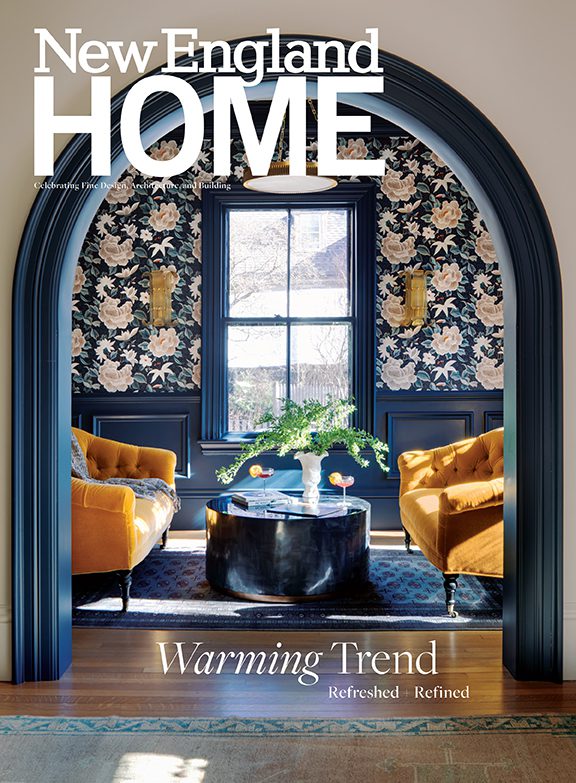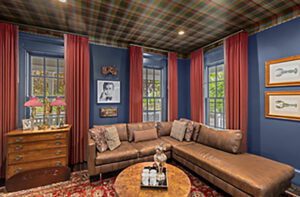Farmhouse Chic
July 25, 2016
A fearless city couple moves to Westport and takes on the renovation of a circa-1832 home with both family and a nod to history in mind.
Text by Maria LaPiana Photography by John Gould Bessler Produced by Karin Lidbeck Brent
A fearless city couple move to Westport and takes on the renovation of a circa-1832 home with both family and a nod to history in mind.
Three years ago, the parents of two little girls (with a baby on the way) were living peaceably in a historic Brooklyn neighborhood, in a charming brownstone they’d renovated themselves, when they decided they needed more space. That, and the prospect of paying private-school tuition for three kids, says Jennifer, sent them packing.
They house-hunted in New Jersey, Westchester, and Long Island, but weren’t thinking about Connecticut. “It just seemed so far away, and we didn’t know anyone who lived there,” says Jennifer. They’d never even heard of Westport until a colleague invited them to visit. “We were blown away by their home,” Jennifer remembers, but more than that, she and Keith found the Westport landscape, the beaches, and the community positively disarming.
The move was something of a blur. Within ten days they had put the Brooklyn house on the market, signing the contract the same day that they brought their baby boy home from the hospital. They spent one marathon day looking at properties, then came upon a farmhouse in the historic Greens Farms neighborhood of Westport, and fell in love—even though they both knew it needed work.
Two things sealed the deal: the outstanding barn addition the previous owners had found in Vermont, dismantled, and reconstructed on the site, and the yard, nurtured for thirty-three years by the master gardener who had lived there. Upon seeing the yard for the first time, the Driscolls’ older daughter asked, “Is this a park?”
The couple called in a trio of professionals to help them bring into being the family home they imagined: architect Ann Sellars Lathrop, builder Bill Towle of Signature Home Remodeling, and interior designer Sara Jordan.
The historic home, built circa 1832, was appealing in many ways—and within commuting distance to New York City, where Jennifer works in finance—but, recalls Sellars Lathrop, “it was outdated and inefficient for a twenty-first-century lifestyle.” The solution: a two-part renovation project. “The first step was to make the first-floor living areas suitable for two working professionals and three children,” says the architect.
The second—a year or so later, they reasoned—would be the addition of a second-story master suite.
Towle, no stranger to extensive renovations, remembers thinking the home had a lot of potential, but truthfully didn’t expect the second-story project would ever see the light of day. “I’d say that 90 percent of the people who say they’re going to do another phase end up not doing it,” he says.
It all happened in short order, however. As the need for structural improvements was discovered, the project not only grew, it picked up speed. “Who knew,” says Jennifer, “that a simple remodel would end up being a full-blown restoration?”
The rear of the house was mostly gutted; walls were removed and steel beams added to create a more open plan (and to support future second-story roof loads).
The team agreed to enhance views of the garden and natural light by adding transom windows throughout. “Remember, we came from a dark brownstone,” says Jennifer. The architect ticks off the rest: new insulation, windows, and doors; an all-new kitchen; new wall and floor finishes; built-in storage; reclaimed ceiling beams; a new mudroom area; and improved access to the garage below. Outside, the rear roof deck was rebuilt and a pergola added.
The Driscolls were on a roll. As soon as the downstairs paint was dry, they embarked on phase two. The master suite was expanded to include an almost complete gut renovation of the second floor, says Sellars Lathrop. They reconfigured bedrooms and opened the attic to create soaring beamed ceilings.
Most of the couple’s decisions were made with respect for history melded with a modern sensibility. “The house has a historic designation, but we didn’t want it to be an 1830s house again,” says Keith, an artist and entrepreneur. “In every architectural detail we changed we gave a nod to the original—but with fresh, modern charm.”
They felt it was important to incorporate authentic materials. For example, they laid down beautiful wide-plank white oak floors throughout the house and opted for a natural finish. The first-floor beams came from an old pickle factory in Springfield, Massachusetts. They had kitchen cabinets custom made by a husband and wife team from Southbury. They chose two-inch quartzite for the counters because it
looks like marble but is more durable and easier to care for. They opted for simple fixtures that helped the kitchen retain a farmhouse feel.
Interior designer Sara Jordan was involved from the start, recommending materials and finishes, even as she advised the couple on how to furnish their new home. “They wanted family-friendly, comfortable rooms with custom touches,” says Jordan. “We went with good lighting, well-scaled classic furnishings, and custom soft goods to add personality. The couple’s original art and books added soul.”
Because Jennifer commutes for three hours every day, she needed a haven at home. “I wanted the master suite to be spa-like,” she says, and it is. It’s simple, elegant, and calming: a sitting room with a white slip-covered sofa, lots of pillows and throws. A few steps up sits the sheltering, upholstered bed and an heirloom wing chair. Keith’s paintings hang on the walls. “The sofa is from Mitchell Gold, and the chandelier over the bed is from Pottery Barn,” says Jordan, “a perfect example of how we combined high and low.”
What didn’t they skimp on? “Anything that people touch,” says Keith, pointing to vintage-inspired faceted glass doorknobs.
Says Jordan: “The entire home was a careful walk between traditional and modern. Jennifer and Keith were wonderful to work with, always mixing and blending in an artful way. I like to say they brought a little bit of Brooklyn to Connecticut.” •
Architecture: Ann Sellars Lathrop, Sellars Lathrop Architects
Interior design: Sara Jordan
Builder: Bill Towle, Signature Home Remodeling
Share
![NEH-Logo_Black[1] NEH-Logo_Black[1]](https://b2915716.smushcdn.com/2915716/wp-content/uploads/2022/08/NEH-Logo_Black1-300x162.jpg?lossy=1&strip=1&webp=1)






















You must be logged in to post a comment.